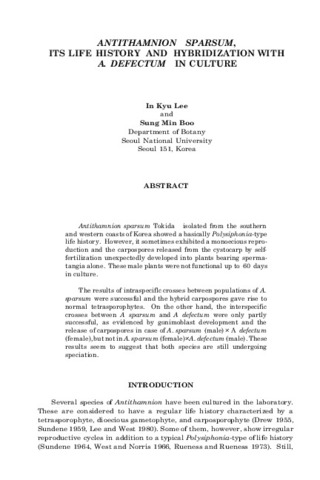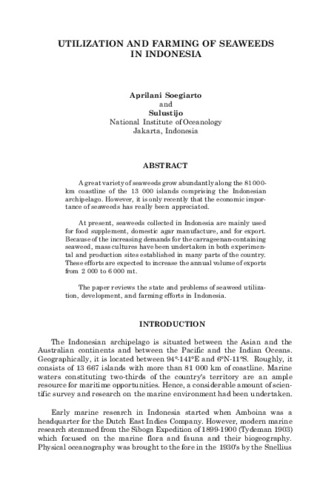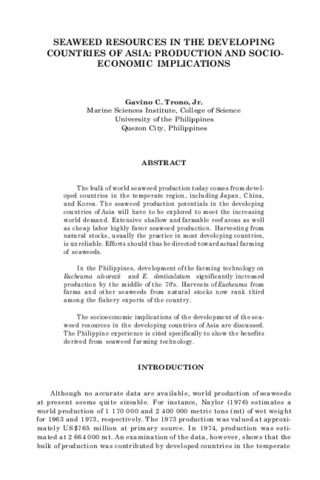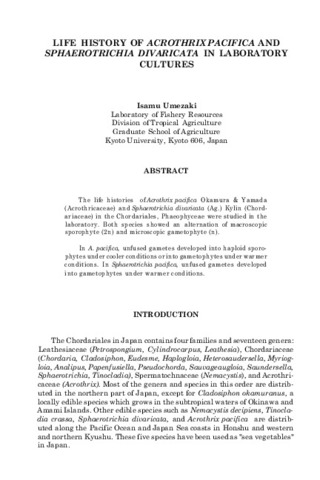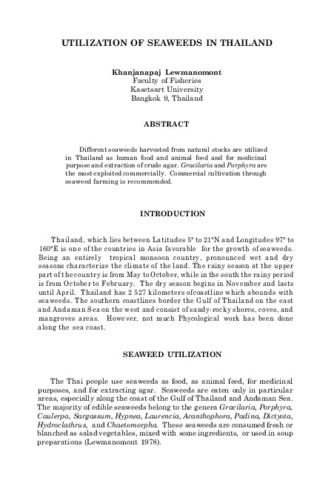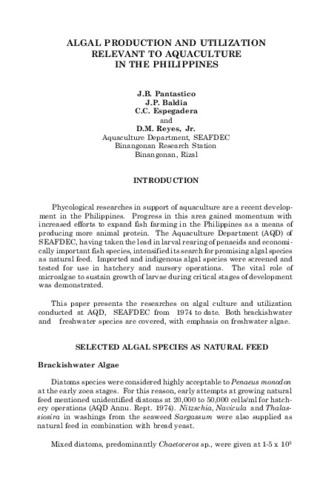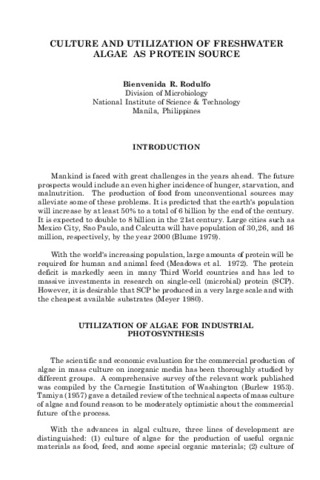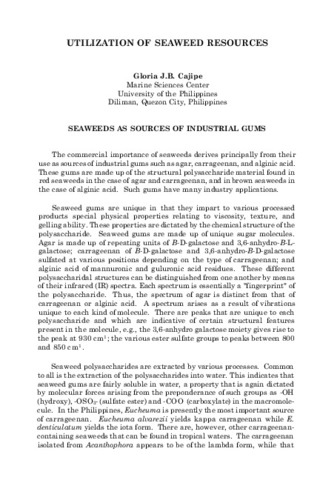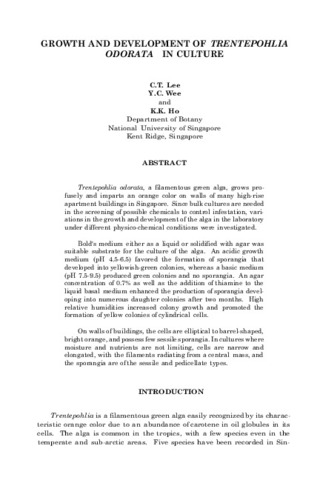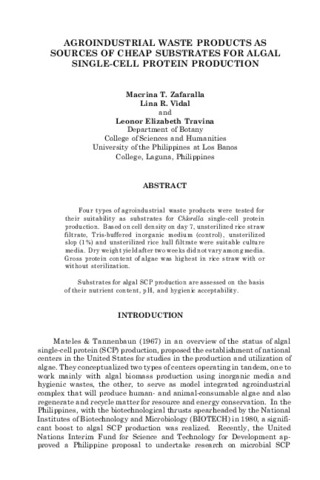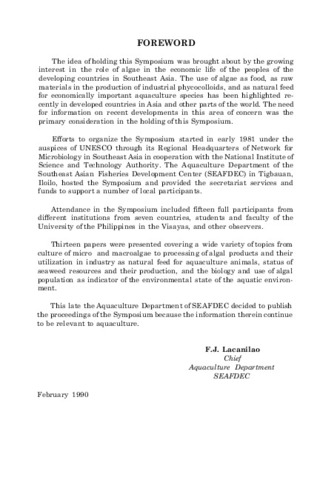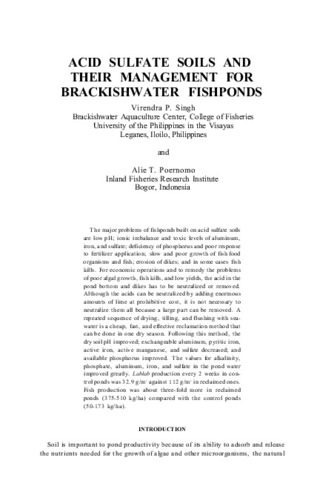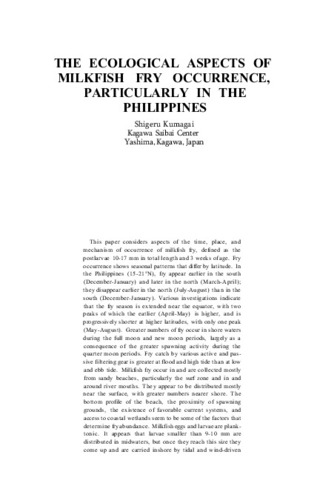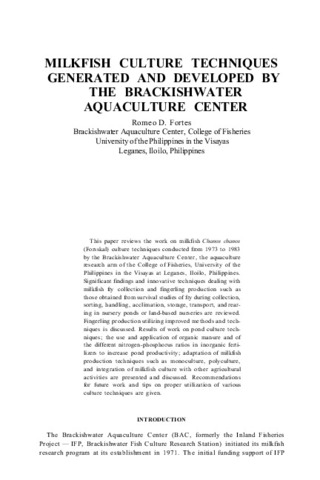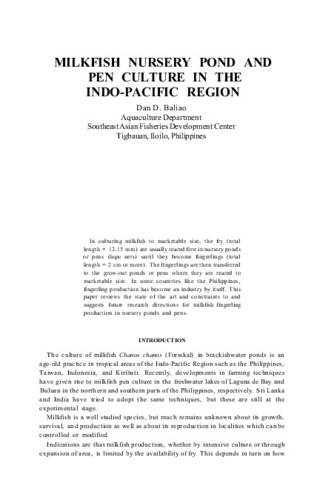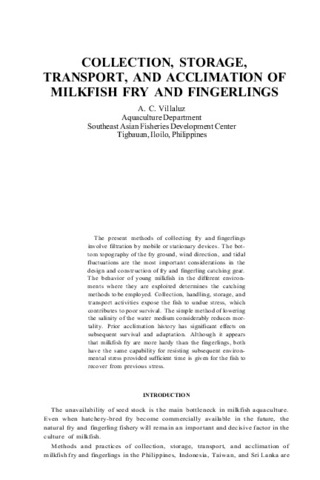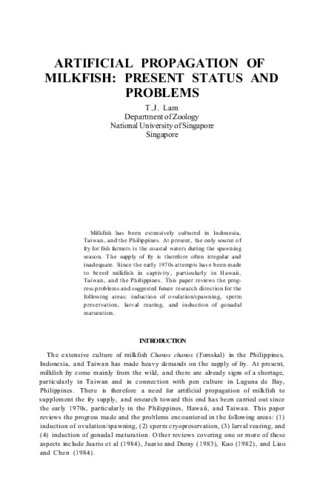Conference Proceedings: Recent submissions
Now showing items 681-700 of 767
-
Antithamnion sparsum , its life history and hybridization with A. defectum in culture
(Aquaculture Department, Southeast Asian Fisheries Development Center, 1990)Antithamnion sparsum isolated from the southern and western coasts of Korea showed a basically Polysiphonia -type life history. However, it sometimes exhibited a monoecious reproduction and the carpospores released from ... -
Utilization and farming of seaweeds in Indonesia
(Aquaculture Department, Southeast Asian Fisheries Development Center, 1990)A great variety of seaweeds grow abundantly along the 81,000-km coastline of the 13,000 islands comprising the Indonesian archipelago. However, it is only recently that the economic importance of seaweeds has really been ... -
Seaweed resources in the developing countries of Asia: Production and socio-economic implications
(Aquaculture Department, Southeast Asian Fisheries Development Center, 1990)The bulk of world seaweed production today comes from developed countries in the temperate region, including Japan, China, and Korea. The seaweed production potentials in the developing countries of Asia will have to be ... -
Life history of Acrothrix pacifica and Sphaerotrichia divaricata in laboratory cultures
(Aquaculture Department, Southeast Asian Fisheries Development Center, 1990)The life histories of Acrothrix pacifica and Sphaerotrichia divaricata in the Chordariales, Phaeophyceae were studied in the laboratory. Both species showed an alternation of macroscopic sporophyte (2n) and microscopic ... -
Utilization of seaweeds in Thailand
(Aquaculture Department, Southeast Asian Fisheries Development Center, 1990)Different seaweeds harvested from natural stocks are utilized in Thailand as human food and animal feed and for medicinal purpose and extraction of crude agar. Gracilaria and Porphyra are the most exploited commercially. ... -
Algal production and utilization relevant to aquaculture in the Philippines
(Aquaculture Department, Southeast Asian Fisheries Development Center, 1990)An outline is given of research conducted at the Aquaculture Department of SEAFDEC at Rizal, Philippines regarding algal culture and utilization. Culture methods for both brackishwater and freshwater algae are described ... -
Culture and utilization of freshwater algae as protein source
(Aquaculture Department, Southeast Asian Fisheries Development Center, 1990)A discussion is presented on the commercial production of algae in mass culture conditions as a source of single-cell protein. Particular reference is made to the food situation in the Philippines, and research conducted ... -
Utilization of seaweed resources
(Aquaculture Department, Southeast Asian Fisheries Development Center, 1990)A brief discussion is presented on the commercial importance of seaweeds in the Philippines, which is mainly concerned with their use as sources of industrial gums such as agar, carrageenan, and alginic acid. Carrageenan ... -
Growth and development of Trentepohlia odorata in culture
(Aquaculture Department, Southeast Asian Fisheries Development Center, 1990)Trentepohlia odorata, a filamentous green alga, grows profusely and imparts an orange color on walls of many high-rise apartment buildings in Singapore. Since bulk cultures are needed in the screening of possible chemicals ... -
Agroindustrial waste products as sources of cheap substrates for algal single-cell protein production
(Aquaculture Department, Southeast Asian Fisheries Development Center, 1990)Four types of agroindustrial waste products were tested for their suitability as substrates for Chlorella single-cell protein production. Based on cell density on day 7, unsterilized rice straw filtrate, Tris-buffered ... -
Foreword
(Aquaculture Department, Southeast Asian Fisheries Development Center, 1990) -
Acid sulfate soils and their management for brackishwater fishponds
(Aquaculture Department, Southeast Asian Fisheries Development Center; International Development Research Centre; Island Publishing House, Inc., 1984)The major problems of fishponds build on acid sulfate soils are low pH; ionic imbalance and toxic levels of aluminum, iron, and sulfate; deficiency of phosphorus and poor response to fertilizer application; slow and poor ... -
The ecological aspects of milkfish fry occurrence, particularly in the Philippines
(Aquaculture Department, Southeast Asian Fisheries Development Center; International Development Research Centre; Island Publishing House, Inc., 1984)Aspects of the time, place, and mechanism of occurrence of milkfish (Chanos chanos ) fry, defined as the postlarvae 10-17 mm in total length and 3 weeks of age are considered. Fry occurrence shows seasonal patterns that ... -
Milkfish culture techniques generated and developed by the Brackishwater Aquaculture Center
(Aquaculture Department, Southeast Asian Fisheries Development Center; International Development Research Centre; Island Publishing House, Inc., 1984)This paper reviews the work on milkfish (Chanos chanos ) culture techniques conducted from 1973 to 1983 by the Brackishwater Aquaculture Center, the aquaculture research arm of the College of Fisheries, University of the ... -
The sense organs and behaviors of milkfish fry in relation to collection techniques
(Aquaculture Department, Southeast Asian Fisheries Development Center; International Development Research Centre; Island Publishing House, Inc., 1984)This paper describes the sense organs and some of the behavioral characteristics of milkfish (Chanos chanos ) fry, based on studies conducted at the Aquaculture Department, SEAFDEC, Philippines and at Kagoshima University, ... -
Milkfish nursery pond and pen culture in the Indo-Pacific region
(Aquaculture Department, Southeast Asian Fisheries Development Center; International Development Research Centre; Island Publishing House, Inc., 1984)In culturing milkfish (Chanos chanos ) to marketable size, the fry (total length = 12-15 mm) are usually reared first in nursery ponds or pens (hapa nets) until they become fingerlings (total length = 2 cm or more). The ... -
Collection, storage, transport, and acclimation of milkfish fry and fingerlings
(Aquaculture Department, Southeast Asian Fisheries Development Center; International Development Research Centre; Island Publishing House, Inc., 1984)The present methods of collecting fry and fingerlings involve filtration by mobile or stationary devices. The bottom topography of the fry ground, wind direction, and tidal fluctuations are the most important considerations ... -
Gonadal development and induced breeding of captive milkfish in Taiwan
(Aquaculture Department, Southeast Asian Fisheries Development Center; International Development Research Centre; Island Publishing House, Inc., 1984)The induced breeding of milkfish (Chanos chanos ) has been attempted by many institutes in the Philippines, Taiwan, Tahiti, Indonesia, and Hawaii. So far, a few successful trials have been achieved only in the Philippines ... -
Artificial propagation of milkfish: Present status and problems
(Aquaculture Department, Southeast Asian Fisheries Development Center; International Development Research Centre; Island Publishing House, Inc., 1984)Milkfish (Chanos chanos ) has been extensively cultured in Indonesia, Taiwan, and the Philippines. At present, the only source of fry for fish farmers is the coastal waters during the spawning season. The supply of fry is ... -
The milkfish industry in the Philippines
(Aquaculture Department, Southeast Asian Fisheries Development Center; International Development Research Centre; Island Publishing House, Inc., 1984)Milkfish (Chanos chanos ) is the most commercially important fish species in the Philippines. Milkfish production from the marine fisheries and aquaculture sectors has increased at an average rate of 22%. In 1981, production ...

